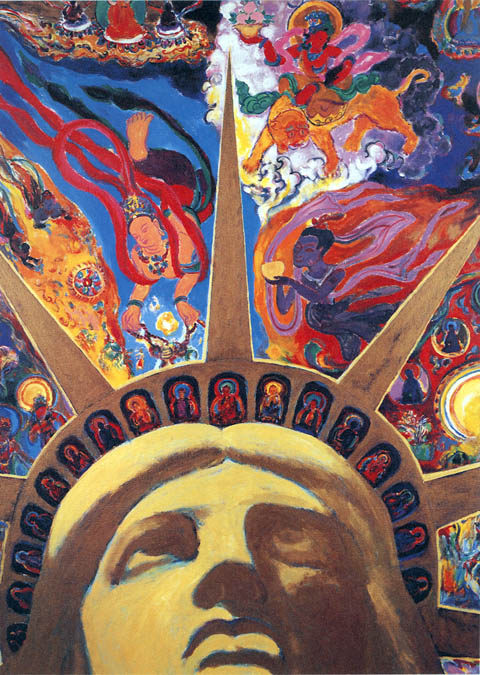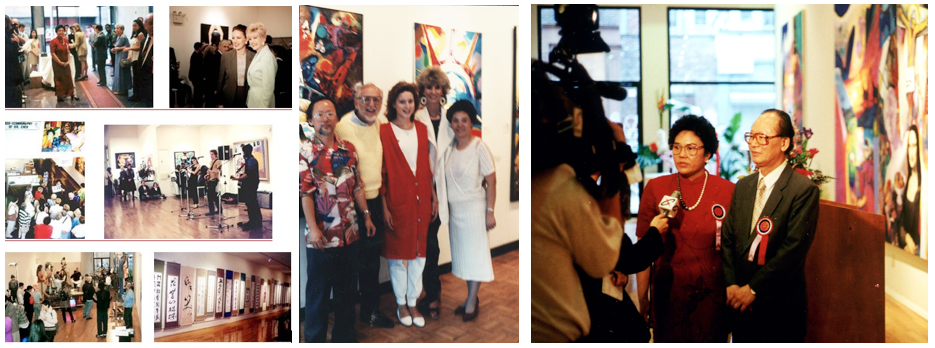East & West
2015 年 10 月 14 日
The Five-Dimensional Apocalypse of T.F. Chen
by Smith except from TF Chen’ philosophy
For East & West series
 All of us live comfortably in a physical three-dimensional world. Although we don’t begrudge accepting time as the fourth dimension, most of us throw up our hands when confronted with any theoretical mathematical constructs that add more dimensions. When Dr. Chen talks about Five Dimensional Universal Civilizations, he is not invoking parameters as we usually think of them. He is giving some new meanings to some old words. Since these meanings unhide the apocalyptic structure of his New-Iconography, it is intriguing to unravel them as best as we can.
All of us live comfortably in a physical three-dimensional world. Although we don’t begrudge accepting time as the fourth dimension, most of us throw up our hands when confronted with any theoretical mathematical constructs that add more dimensions. When Dr. Chen talks about Five Dimensional Universal Civilizations, he is not invoking parameters as we usually think of them. He is giving some new meanings to some old words. Since these meanings unhide the apocalyptic structure of his New-Iconography, it is intriguing to unravel them as best as we can.Let us start with an easy four dimensional look at the Western world Chen discovered in Paris. Chen’s eye and mind discerned four societies that led to the modern West. He gave each a visual symbol—hence, four dimensions of his defining.
He let the pyramid symbolize the essential of Egyptian civilization, which was geometric, firm, collective, immobile, hierarchic, stubborn, and sealed off, with a preoccupation for abstraction, stylization, and eternity.
He depicted the Greeks with a series of vertical lines, representing columns. The ardent Greek spirit evoked a passion for liberty, clarity, democracy, eloquence, personal development, proportional beauty, harmony, equilibrium, and a search for ideals.
 Venus and Shogun/ #78009 / 50X 72″/ ac Venus and Shogun/ #78009 / 50X 72″/ ac |
 Enriching East West(B)-Mixed Media on paper-30X40''-1994.4 Enriching East West(B)-Mixed Media on paper-30X40''-1994.4 |
As to Judeo-Christianity, he used the Christian cross as a symbol of one true God, a soaring verve, sacrifice to the point of martyrdom, mysticism, and ideal of personal salvation.
Chen saw these four symbols being pushed together until they synthesized a composite Western civilization, a new fifth dimension, which he depicted schematically as a sort of cathedral: a series of columns supporting a pyramidic pediment circumscribed by a dome-like arch, supporting a skyward cross.
 Old new East West Painting writing (B) / 158.3×129cm
Old new East West Painting writing (B) / 158.3×129cm |
 Greetings From The East /66x48’’ / ac
Greetings From The East /66x48’’ / ac |
Do you like it?
2015 年 10 月 17 日
 Inside, the gallery showcases a rotating exhibition by different artists associated with the NWAC. In 1996, the Center opened with a retrospective of Chen’s work t date, reflecting a career spanning 45 years, from 1951 to the post-modern “Neo-I” art. dubbed the prophet of neo-iconography by critic Lawrence Jappson in 1978, T.F. Chen’s paintings are based upon the creative manipulation of readily recognized images. “Art and society,” according to Jeppson, “are held together by a matrix of shared visual experiences,’ Chen thus becomes “an exciting matchmaker of West and East, seeking to bind a fragmented world with his art.”
Inside, the gallery showcases a rotating exhibition by different artists associated with the NWAC. In 1996, the Center opened with a retrospective of Chen’s work t date, reflecting a career spanning 45 years, from 1951 to the post-modern “Neo-I” art. dubbed the prophet of neo-iconography by critic Lawrence Jappson in 1978, T.F. Chen’s paintings are based upon the creative manipulation of readily recognized images. “Art and society,” according to Jeppson, “are held together by a matrix of shared visual experiences,’ Chen thus becomes “an exciting matchmaker of West and East, seeking to bind a fragmented world with his art.”

Lucia Curated many art shows for New World Art Center /Warner Brother movie producer: David Wolper & family take photo with Lucia and TF Chen/ Media Interview T.F.Chen &Lucia during the museum opening
Born and raised in Taiwan, T.F. Chen is himself a product of Eastern and Western influences. In 1963, Chen went to Paris on an art scholarship offered by the French Government, and spent the next 12 years earning his Ph.D. in art history at the Sorbonne and studying painting at the Ecole des Beau-Arts. During this period, he also wrote books and magazine articles on art for publication in his homeland where they were ready eagerly by other Taiwanese who were becoming increasingly oriented toward Western culture. Among them was Chen’s future wife, Lucia. The two finally met in Paris and got married in 1975. Lucia Chen is a formidable woman, who one art critic calls “the mediator between Dr. Chen and the outside world.” Educated at Taipei Normal College, the University of Paris and the University of Maryland, Lucia entered the esoteric international art scene with virtually no knowledge of art, but emerged 20 years later art dealer, agent, advisor, publisher and collector. As if that isn’t enough, Lucia also devoted much of her seemingly boundless energy to writing numerous articles on the international art market and collecting African art and master prints. After relocation to the U.S., the couple started a family in Maryland with the birds of their son Ted and daughter, Julie. Then in 1980, in part to launch a campaign t further her husband’s career as a painter, Lucia opened her first gallery in their home in Georgetown with money borrowed from friends and relations.
“In those days, I went to every international art fair and exposition in the country,” she recalls. “It was a very hard life – packing, shipping, setting up booths, re-packing, shipping, going to New York, to California, coming home, then going off again right away.”
After relocation to the U.S., the couple started a family in Maryland with the birds of their son Ted and daughter, Julie. Then in 1980, in part to launch a campaign t further her husband’s career as a painter, Lucia opened her first gallery in their home in Georgetown with money borrowed from friends and relations.
“In those days, I went to every international art fair and exposition in the country,” she recalls. “It was a very hard life – packing, shipping, setting up booths, re-packing, shipping, going to New York, to California, coming home, then going off again right away.”Do you like it?

